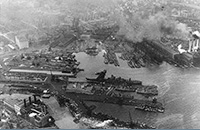Brooklyn Navy Yard
The Brooklyn Navy Yard used asbestos extensively, exposing thousands of workers to the toxic mineral. During WWII, its staff grew to 70,000 men and women. Decades later, many former employees developed asbestos-related illnesses, such as mesothelioma, from asbestos exposure at the shipyard.

History of the Brooklyn Navy Yard and Asbestos
President John Adams established the Brooklyn Navy Yard, along with 4 other sites, as the nation’s first naval shipyards in 1801. Asbestos use at the shipyard began as it prepared for World War II. From that point on, asbestos use was widespread at the yard.
Workers mixed asbestos fibers on-site for insulation. Airborne fibers put everyone at risk, not only those directly handling the mineral.
Asbestos use was so common at the Brooklyn Navy Yard that workers in at least 19 different trades at the yard handled it. Some jobs carried higher risks. For example, boiler workers and insulators were among those who faced some of the heaviest exposure to asbestos. The risk of inhaling asbestos fibers at the yard affected military and civilian workers.
The Brooklyn Navy Yard closed in 1966. But decades later, many former workers developed serious asbestos-related illnesses like mesothelioma from inhaling asbestos fibers from their time at the yard.
Asbestos Products at Brooklyn Navy Yard’s Shops
Raw asbestos was present at the Brooklyn Navy Yard and was mixed on-site in dedicated shops that produced asbestos products, particularly insulation. The yard’s pipe shop made asbestos lagging, a cloth used to insulate hot water and steam pipes on ships.
Asbestos Products Used at Brooklyn Navy Yard
- Electrical insulation for wiring and equipment
- Fireproofing materials for bulkheads and other areas
- Gaskets for sealing machinery and piping systems
- Insulation for pipes, boilers and equipment
- Safety gear, including goggles, gloves, helmets and dust respirators
Exposure wasn’t limited to those making these asbestos products. Asbestos-containing products were used extensively throughout the Brooklyn Navy Yard. This put everyone who repaired, worked with or worked near these products at risk.
Asbestos insulation made at Brooklyn Navy Yard was used extensively throughout ships and facilities throughout the complex. Welders and foundrymen at the yard wore asbestos-lined protective gear.

Learn about your diagnosis, top doctors and how to pay for treatment.
Get Your Free GuideWhy Was Asbestos Used at the Brooklyn Navy Yard?
Asbestos was widely used at the Brooklyn Navy Yard because of its fire-resistant, durable and affordable qualities, which made it ideal for shipbuilding and repair. The toxic mineral was used in a number of products to prevent heat loss and fire hazards.
Its ability to resist corrosion and saltwater made asbestos a popular choice in shipbuilding and shipyards. The Navy used more asbestos than any other branch of the military. It was required in 1922 when building new submarines.
Asbestos products were also used in construction materials in shipyard buildings from flooring tiles to asbestos sheets for roofing. Asbestos was commonly used for building supplies because of its versatility and strength.
Historic Brooklyn Navy Yard Health Report
As early as April 1940, the medical officer at the Brooklyn Navy Yard released a health report in which he recommended “periodical physical exams” for “employees exposed to potential health hazards.” The list of potentially at-risk employees included “amosite or other asbestos workers.” These records prove that as asbestos use was approaching its peak, there was already an understanding of the potential health threat asbestos posed at the Brooklyn Navy Yard.
Despite known health concerns, asbestos use continued at the site until it closed in 1966. In 1969 New York City reopened it as an industrial park. Seatrain Shipbuilding, it’s largest tenant, was a private shipbuilding company, according to The Brooklyn Navy Yard Development Corporation. Asbestos use in shipbuilding was extensive until public concern about health risks led to its phase out beginning in the mid- to late 1970s and early 1980s.
Removing Asbestos From the Brooklyn Navy Yard
Shipbuilding ended at The Brooklyn Navy Yard when Seatrain declared bankruptcy in 1981. Since then, the site has been home to several businesses, including a film studio, manufacturers and tech startups. Asbestos remediation is part of the ongoing site transformation.
Asbestos abatement company Hi-Tech Environmental Renovation shares details in its Brooklyn Navy Yard case study. The company claims, “One of the most ambitious and high-profile urban redevelopment projects in New York City is the ongoing transformation of the Brooklyn Navy Yard…many of the historic buildings at the Navy Yard contained hazardous materials, particularly asbestos, which had to be safely removed before renovation could begin.”
The company says “months of meticulous abatement work” took place, and the buildings at the site “were cleared of asbestos.” Redevelopment continues today. In addition to asbestos cleanup, upgrades are underway at the yard thanks to nearly $29 million in FEMA funding awarded in January 2025 for long-awaited repairs to buildings Hurricane Sandy damaged in 2012.
Recommended Reading


